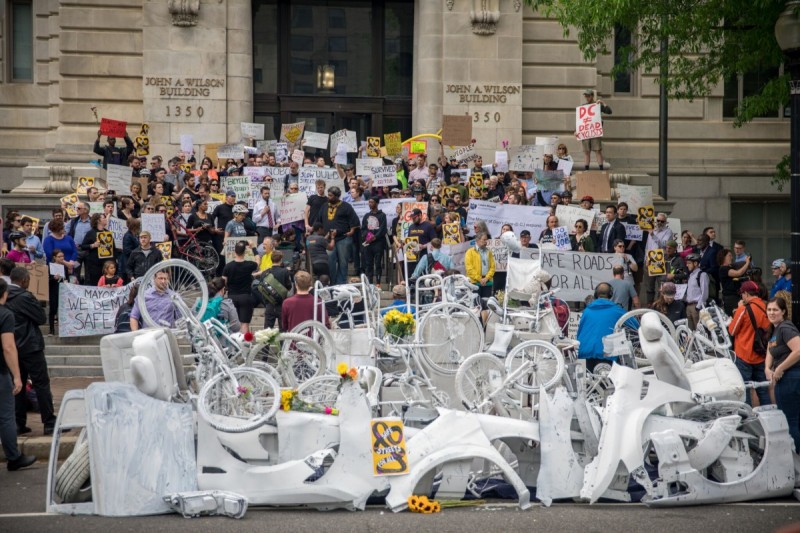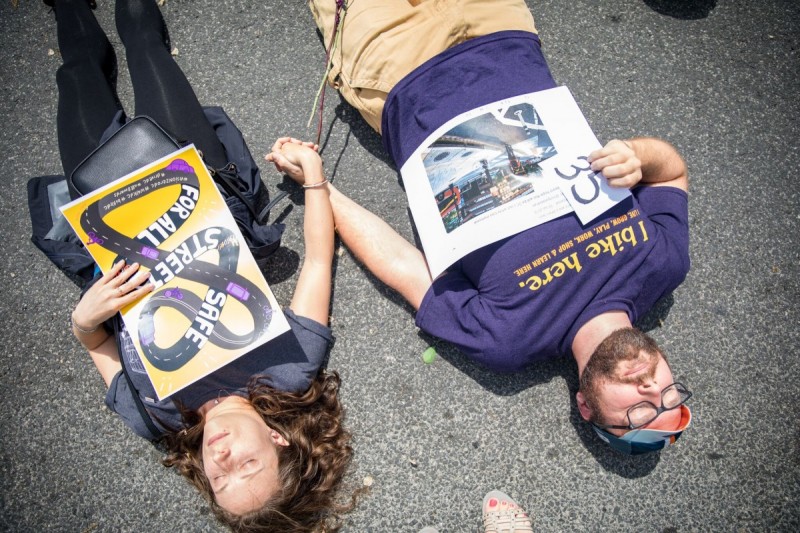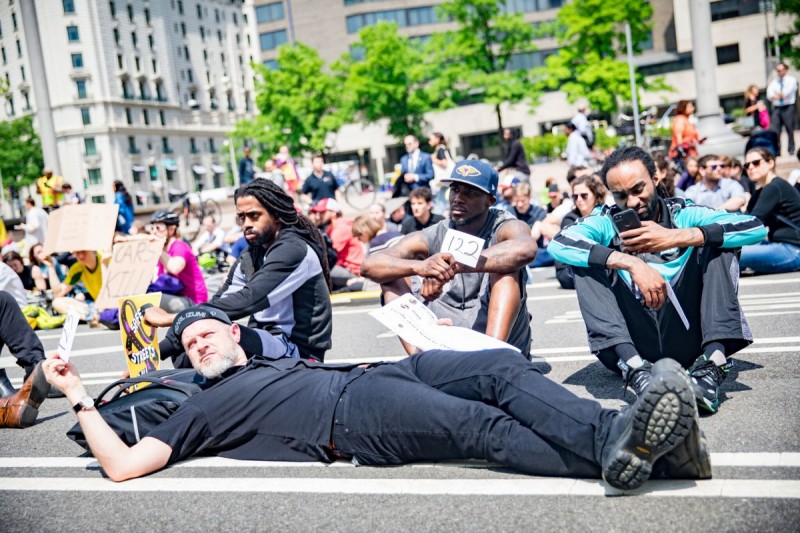Hundreds “die” on Pennsylvania Avenue for streets that don’t kill

All photos by Aimee Custis unless otherwise noted.
A few hundred people rallied in front of the John A. Wilson Building at noon on Friday to demand “streets that don’t kill people” in the District. Protesters laid down on Pennsylvania Avenue and blocked the street for about eight minutes, a nod to the eight road deaths that have occured in the District so far this year.
The rally, organized by the Washington Area Bicyclists Association (WABA), was a response to a rising number of traffic fatalities and injuries in DC. There were three road deaths over the weekend: New York-based pedestrian Abdul Seck, GGWash contributor and bike safety advocate Dave Salovesh, and an unidentified driver who struck a tree on East Capitol Street NE.
“We’ve spent the past five years being asked to be patient and to trust the executive branch, that they are doing everything they can. It’s abundantly clear that everything they think they can do isn’t good enough, so we’re here asking them to think bigger, do more, and do it faster,” said WABA’s Communications Director Colin Browne. “We’re asking the council to make sure they have the resources they need to do that, and accountability if they don’t.”
A community is grieving
As people laid down to block the road, walking advocate Christy Kwan read the names of 128 people who have died on DC streets during Mayor Muriel Bowser’s administration.
“We’re grieving, we’re hurting, we’re raw, we’re mad,” said cyclist and road safety advocate Rachel Maisler, who knew Salovesh. “Every time I organize a memorial, I say I don’t have the energy to do it again. But then I have to do it again, I have to find the energy, and I don’t know how long that energy is going to last. Somebody needs to fix our streets.”
Councilmember Charles Allen, Deputy Mayor Lucinda Babers, and activists took turns speaking about the need for urgency. Rally-goers chanted “Safe streets now!” and “Whose streets? Our streets!”
A cyclist holds up the bike she was riding when a driver hit her from behind. 
“I’m here because bicycling is my primary form of transportation in DC. Most people don’t know I have a car here and these people could have been any of us,” said Devan Tracy, a Ward 3 resident who attended the event. “I think everybody’s had at least one close call, and a close call is just a millisecond away from really bad.”
“I want to be able to bike safely and not die. I think that cities are better if they are focused around people and not moving cars. In one sense I want a better city, but also it’s a really basic thing. We should be able to get around our city safely,” said Owain James, a 23-year-old Ward 1 resident. “We have a bike master plan. We know how to make the streets safer. Safety should not be something that we debate.”
Ward 8 resident and activist Ron Thompson speaks at the rally. 
Advocates say the DC Council needs to act now
Browne says that WABA wants a lot of the projects that are still in the planning stages—in particular sidewalks, safer intersections, and protected bicycle lanes—to be installed immediately. The organization would also like to see 20 new miles of protected bike lanes by 2020.
More broadly, WABA also wants the council to change some of its decision-making framework.
“We’re still operating in a transportation environment where one person with some time and money a complaint about a parking space can hold up a street safety project for years,” Browne said. “The default is still using tools that were designed to build interstate highways to make safe streets, and that needs to change.”
WABA wants the city to replace Level of Service (LOS) engineering standards with a Vehicle Miles Traveled (VMT) reduction planning framework, in other words, instead of building streets to move cars without slowing them down, the streets are built to reduce driving. Other jurisdictions have adopted this framework, including the state of California.
“We need to do more, and we need to do it faster,” agrees Councilmember Elissa Silverman, who has bicycled in DC for decades. “It’s not just about cycling, it’s about making sure the streets are safe for everyone. There are car deaths that are preventable, pedestrian deaths that are preventable, and we need to make it a political focus.”
A closer look at the protest art placed in front of the Wilson Building representing the 128 people who have died on DC streets during the Bowser administration. White-painted "ghost bikes" are often places in the spot where a cyclist was killed by a driver. Image by John Sonderman licensed under Creative Commons.
“We’re not going to have more people dying because people don’t want to give up street parking that they don’t even use,” said Ron Thompson, a Ward 8 resident and activist who spoke at the rally. His mother was struck in the same intersection where Abdul Seck was killed. “Our lives matter too. And if you say that, then you have to prove it by giving us the investments that we need.”
Thompson says DDOT should do a comprehensive review of every street in the District to figure out what improvements must be made in order to make them safe for people using all modes of transportation. In addition to that, he says particular attention should be paid to underserved areas of the city.
“We need to put our people to work in Ward 7 and 8. We have the highest rates of unemployment. This mayor and this council can establish the largest public works program in the District since the days of ‘Boss’ Shepherd to put people to work building the sidewalks, painting the crosswalks, putting the stop signs in place,” Thompson said. “We can tackle two birds at once. We can put people to work, but we can keep people safe as they get to work to school from home.”
Robb Dooling, a neighborhood activist and former ANC commissioner, offered words of encouragement for those frustrated and tired of the fight for safe streets.
“In the memory of my friend Dave Salovesh, and the other 127 lives we’ve lost under Mayor Bowser’s failed Vision Zero, don’t give up,” Dooling said. “Don’t give up unless Mayor Bowser builds a city not for cars, but for people.”









